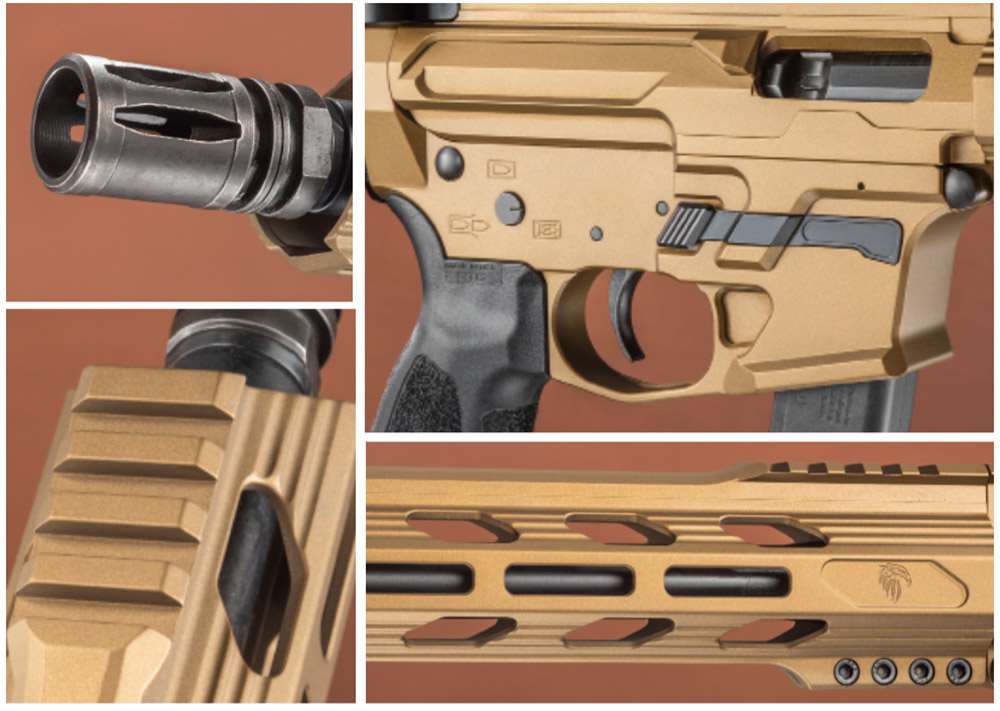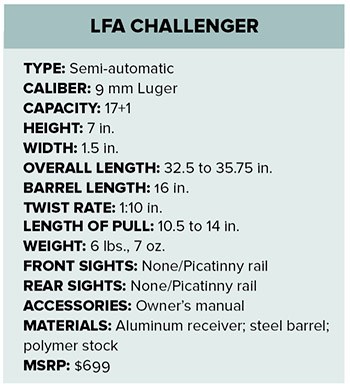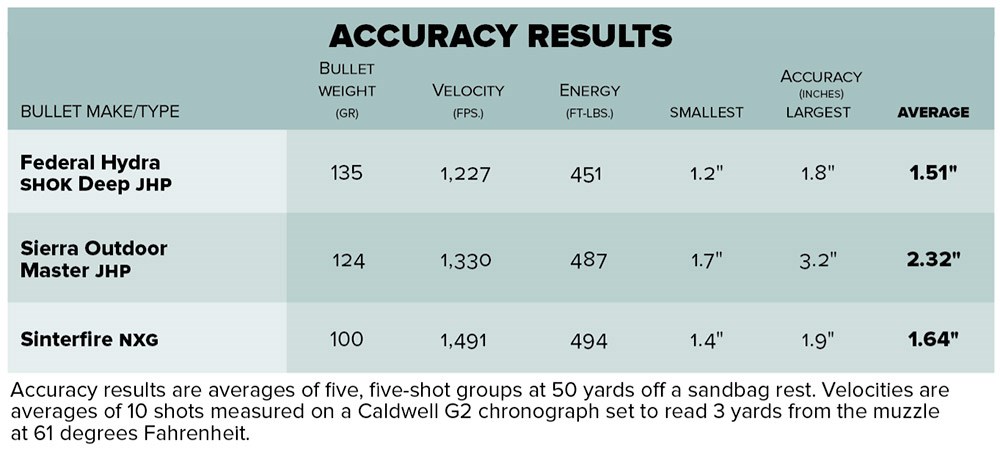Gun Review | LFA Challenger
When it comes to firearms in the AR-15-style, the entire gun industry seems to gravitate toward chambering in 5.56 mm, so much so that the rifle is almost exclusively associated with it. Yet, with more than 80 possible chamberings, the AR-15 is perhaps the most-versatile platform ever, so it’s curious why the other possibilities have so often been ignored.
Fortunately, this trend is changing. Over the past few years, pistol-caliber carbine (PCC) variants have been showing up, largely driven by their competitive acceptance. One significant selling point for this is that alternate chamberings might be less expensive to shoot over time.
Yet, even so, the initial investment in an AR can often be enough to push off the realization of that savings for longer than many people consider reasonable. The industry is answering this concern as well, though.
- Buy All-American!
- Bring health and vitality back to your body with these non-transdermal patches
- Get your Vitamin B17 & Get 10% Off With Promo Code TIM
- How To Protect Yourself From 5G, EMF & RF Radiation - Use promo code TIM to save $$$
- The Very Best All-American Made Supplements On The Maret
- Grab This Bucket Of Heirloom Seeds & Save with Promo Code TIM
- Here’s A Way You Can Stockpile Food For The Future
- Stockpile Your Ammo & Save $15 On Your First Order
- Preparing Also Means Detoxifying – Here’s One Simple Way To Detoxify
- The Very Best Chlorine Dioxide
- All-American, US Prime, High Choice Grass-Fed Beef with NO mRNA, hormones or antibiotics... ever!
After proving that aluminum- framed pistols don’t need to cost a fortune, Live Free Armory (LFA) decided to set its sights on an affordable PCC, resulting in the Challenger, a 9 mm that shines in the competitive arena, but which is also a good candidate for home defense.

Whenever I hear “affordable firearm,” I like to research how the gun is made. I dig inexpensive firearms, but I also value my fingers too much to trust anything “cheap.” LFA kept it simple with a direct-blowback system to manage chamber pressure. In place of some sort of delay system, like a rotating bolt, this carbine simply places more mass toward the end of the carrier and employs a heavier spring to keep the action closed longer while firing. This allows the bullet to travel further down the barrel (or leave it altogether) before the action opens, which also reduces the pressure from the burning gases to a level that is operationally safe. Having a reduced number of parts (no gas block and gas tube) also cuts manufacturing costs. It ultimately makes the gun inherently more reliable because the parts that need to interact in a certain sequence are no longer there.
We live in a world where most folks are drawn to new technology, but products of a simplified nature still provide the benefits of lower cost. Reducing the number of firing components leaves money for the most-sought PCC features, especially when nearly everything is made in-house. LFA mills its own receiver sets from billet aluminum, which yields a sturdier base than expedited forging processes. Both halves are machined together, ensuring the sides fit each other perfectly. The hand guard is also LFA’s own and is cut to a thin profile to allow for better purchase with C-gripping styles. Wrapping my fingers around it, I appreciated the omission of Picatinny sections where not needed. Instead, there are 180 degrees of MLOK slotting and rhombus-shaped grooves that accommodate your fingertips to help keep your hand in place during recoil. A 16-inch, light-contour barrel slides through and is capped with a flash hider.

I found the Challenger’s controls to be well thought out, starting with the magazine release. Swept back, it allows right-handed people to actuate it with their trigger finger while not placing it so far rearward that lefties can’t reach it with their support thumb. An enlarged bolt stop is placed on the other side of the carbine and accommodates both dexterities. Lastly, a standard charging handle is installed to keep the profile slim. As PCCs seldom wear optics with large ocular lenses, extending this component would become more of a liability than an asset.
The machined-in rail makes the Challenger optics-ready right out of the box. If you prefer to run iron sights, a 12 o’clock Picatinny section is situated toward the muzzle end of the hand guard. I chose a Primary Arms Classic Series red-dot sight, as it’s affordable and pairs perfectly with the LFA PCC. Aside from a low price, its 3-MOA aim point is visible, even at the lower settings. As it includes a QD mount already attached, I spent more time pondering placement than I did actually affixing it to the gun.
 This just left ammunition. As usual, I considered use before making my selections. PCCs are allowed at most indoor ranges, but older locations often have poor ventilation. Therefore, I decided to run Sinterfire’s lead-free NXG ammo, a clean option for an indoor range session.
This just left ammunition. As usual, I considered use before making my selections. PCCs are allowed at most indoor ranges, but older locations often have poor ventilation. Therefore, I decided to run Sinterfire’s lead-free NXG ammo, a clean option for an indoor range session.
After practice, the subsequent logical use for this firearm is defense, so I slid over to the hollow-point section. If you need to defend the henhouse, Sierra makes an excellent 124-grain load called the Outdoor Master. For more-typical self-defense, it would be difficult to do better than Federal’s Hydra-Shok Deep.
My range day began with a formal consistency test. Despite coming with a defensive-minded 6.5-pound trigger pull, the Challenger was accurate, with only one group over the 3-inch mark at 50 yards (and it’s fair to attribute a little of that to shooter error). As expected, every round, including the hollow-point fodder, cycled through the action without any issue.
The Challenger did lock open on an empty magazine. (The competitive world is moving away from this feature, but in my opinion, it is critical for the defender.) It takes Glock-pattern mags—and there is a vast aftermarket for these.
Moving from the bench, I reloaded with a 33-round stick magazine from a previous project and addressed a sea of silhouette targets ranging from 15 to 109 yards. Driving my fingers deep into the handrail grooves, I engaged them all in rapid succession while advancing and retreating to cover. Recoil was as expected for 9 mm. I found the muzzle rise to be manageable and the gun pointed instinctively. Reloading went smoothly and was expedited by the enlarged and flared magazine well.
I finished my range day by exhausting more than 200 rounds of ammunition. I didn’t experience a single hiccup, which is to be expected from a direct-blowback PCC. The only issue I had was with a loose screw on the muzzle brake—an easy fix.

But, while it may sound like direct-blowback action is the undisputed champion of action styles, there aren’t any free lunches in life. They do run dirtier, and the gun required a cleaning afterward; however, due to its lower parts count, the cleaning went faster than usual.
All in all, for $679, I found this to be an excellent firearm to have in my collection—especially given that owning a Challenger will let me enjoy less-expensive 9 mm ammunition.
Article by FRANK MELLONI
Don't forget to like us on Facebook and follow us on Twitter.














